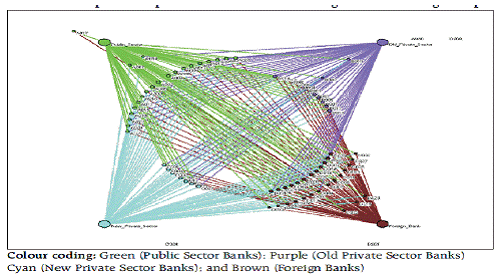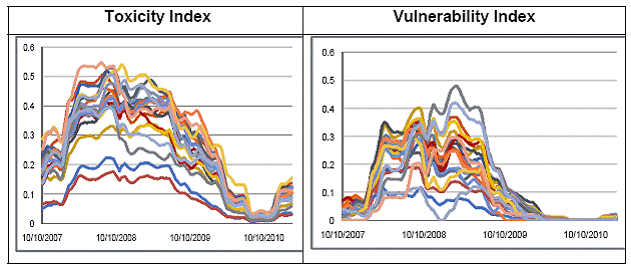The Reserve Bank of India presented its assessment of the health of India’s financial sector in its Financial Stability Report (FSR), released here today. The report reflects the Reserve Bank’s continuing endeavour to communicate its assessment of the incipient risks to financial sector stability. The first FSR was released in March 2010 and the second in December 2010. Going forward, FSRs will be released bi-annually in June and December every year. As in the case of the previous reports, this FSR holistically assesses, from a systemic risk perspective, disparate elements of the financial sector eco-structure – the macroeconomic setting, policies, markets, institutions. However, the tools and techniques used to assess the stability of the financial sector, the build up of systemic risks, if any, and the movements of various vulnerabilities between December 2010 and June 2011, have been considerably upgraded. The FSR states that the Indian financial system remains stable in the face of some fragilities being observed in the global macro-financial environment. Growth is slackening in most parts of the world, even as the risks from global imbalances and sovereign debt crises in Europe continue to hover. The uncertainties in global environment with persistently high energy and commodity prices have contributed to a slight moderation in India’s growth momentum as well. The macroeconomic fundamentals for India, however, continue to stay strong, notwithstanding the prevailing inflationary pressures and concerns on fiscal fronts. During the period since the publication of the previous FSR in December 2010, Indian financial markets have remained stress free, according to the FSR, even as the reliance of domestic firms on international sources of finance denominated in foreign currency has been growing. The regulatory arrangements are being strengthened, emphasising a coordinated approach, in line with the current international developments and best practices. The FSR assesses that the banking sector continues to be stable, though the structure of the sector - characterized by significantly ‘connected’ and ‘clustered’ banks, carries certain inherent risks, as shown by the Network Analysis - one of the newly introduced analytical techniques in this FSR (diagram below).  | The Banking Stability Indicator, introduced in the previous FSR, endorses the overall improvement in the stability of banking sector, according to the FSR. The various macro-financial stress tests, including the newly introduced ones based on more rigorous computation methodologies; also show that the banking sector remains adequately capitalised and resilient to asset quality shocks and other plausible adverse changes in macroeconomic scenario. For the purpose of assessing the systemic importance of individual banks, the probability of a bank causing distress to another bank or being affected by the distress of another bank have been analysed through the construction of, inter alia, ‘Toxicity Index’ and a ‘Vulnerability Index’ for each bank, which have been presented in the FSR (diagrams below).  | Reflecting deepening inter-regulatory collaborative process for financial stability, this FSR carries significant contributions from the Securities and Exchange Board of India (SEBI) and the Insurance Development Regulatory Authority (IRDA) on systemic issues pertaining to the respective segments. The next FSR is scheduled to be published in December 2011. Highlights Global Macroeconomic Developments -
The global risk scenario has improved, though there are signs of a slowdown in growth during 2011 in most countries, including some developing economies in Asia. -
The main underlying factors causing global imbalances remain largely unaddressed, increasing the uncertainty around the path of global recovery. -
The sovereign debt crisis in some Euro area countries and the increasingly high levels of government debt in some advanced countries remain threats to global stability. Domestic Macroeconomic Developments -
There are downside risks to GDP growth on account of some domestic and international factors. -
Inflation is likely to continue facing upward pressure. -
Financing of the CAD is not a major concern at present although slow down in capital inflows could occur as the advanced economies exit from the accommodative policy. -
Management of government expenditure will pose challenges to the process of fiscal consolidation. Financial Markets -
The domestic financial markets remain stress free and are expected to remain so in the near term. -
Liquidity in the system remained in deficit mode given strong credit demand and high level of currency in circulation. -
Government bond yields hardened across all maturities, more so in the short end, resulting in a flattening of the yield curve. -
Greater access of domestic corporates to ECBs has resulted in increased currency mismatches. -
Domestic corporate issuers of FCCBs may face refunding risks as many bonds nearing maturity by March 2013, may not be converted to equity. -
Events like ‘flash crashes’ witnessed in US equity markets in May 2010, need to be guarded against even as program trading systems are introduced in the country. Financial Institutions -
The banking sector remains well capitalized with both core capital adequacy and leverage ratios at comfortable level. -
Credit growth rebounded amid improvements in asset quality. Certain specific sectors, however, may pose concerns, going forward. -
Increased reliance of market borrowings could adversely affect the liquidity position of banks. -
The robust growth in credit warrants tightening of individual underwriting standards to prevent slippages when credit growth slows. -
Banks’ profitability improved, buoyed by increased net interest income though non-interest income remained stagnant. Going ahead, cost factors may impact profitability. -
Increase in off balance sheet exposures, especially in case of foreign banks, may need to be monitored. -
The insurance sector in the country has, over the years, grown in size and reach, particularly after opening up to private players. The sector remains robust and well regulated. Regulatory environment -
Proposed amendments to banking legislations are expected to fortify the regulatory structure. -
Banks in India will face many challenges as they migrate to the advanced approaches under Basel II and prepare for Basel III. -
The calibration of the countercyclical buffers proposed under Basel III will require a combination of qualitative judgment and quantitative indicators. -
There remain gaps in the regulatory framework for NBFCs while raising of funds by cooperative societies outside any regulatory ambit needs to be addressed. -
The systemic importance of Government owned NBFCs has grown and the regulatory exemptions granted to such entities are being reexamined. Financial Market Infrastructure -
The operational performance of the payment and settlement infrastructure in India continued to be robust. -
The integration and inter-relationships among various segments of the payment and settlement systems could pose some concerns. -
The management of liquidity risks faced by the CCPs needs to be carefully managed given the collateral damage from any failure, however unlikely. -
The existing reporting arrangements for OTC derivative markets need to be leveraged as more products /markets are brought within the reporting framework. Stress testing -
A series of stress testing in respect of credit, liquidity and interest rate risks showed that banks remained reasonably resilient though their profitability could be affected significantly. -
Under severe stress scenarios, banks may face liquidity constraints. -
Banks need to remain vigilant to the headwinds from the prevailing inflation and interest rate situation which may affect their asset quality as changes in interest rate were found to have the most significant (negative) impact on slippage ratio of the banks. -
A new set of banking stability measures revealed that, when assessed from different combinations of distress dependencies, systemic risks rise faster than individual risks of banks during periods of crisis. Ajit Prasad
Assistant General Manager Press Release : 2010-2011/ 1814 |
 IST,
IST,





















